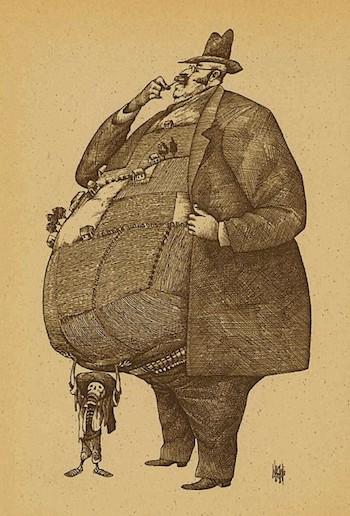 (This image of rich and poor is by Rogelio Naranjo, and was found at Phawker.com.)
(This image of rich and poor is by Rogelio Naranjo, and was found at Phawker.com.)It would be a huge understatement to say the billionaires are doing well. Between 1990 and 2020, the wealth of U.S. billionaires climbed by 1130%.
And they have not been hurt by the pandemic. Between March 18th and April 10th (as over 22 million workers lost their jobs), the wealth of U.S. billionaires increased by 10%.
But the same cannot be said of the middle and working classes. They are struggling just to maintain their economic state, and many are sliding into poverty because of lost jobs. And this is a worldwide phenomenon.
The pandemic may not be affecting the rich, but it is causing as many as a half-billion people to slide into poverty worldwide.
Consider this small part of an article in The New York Times by Maria Abi-Habib:
The World Bank says that for the first time since 1998, global poverty rates will rise. By the end of the year, 8 percent of the world’s population — half a billion people — could be pushed into destitution, largely because of the wave of unemployment brought by virus lockdowns, the United Nations estimates. . . .
While everyone will suffer, the developing world will be hardest hit. The World Bank estimates that sub-Saharan Africa will see its first recession in 25 years, with nearly half of all jobs lost across the continent. South Asia will likely experience its worst economic performance in 40 years.
Most at risk are people working in the informal sector, which employs two billion people who have no access to benefits like unemployment assistance or health care. . . .
The financial shock waves could linger even after the virus is gone, experts warn. Countries like Bangladesh, which spent heavily on programs to improve education and provide health care, which help lift families out of destitution, may now be too cash-strapped to fund them. . . .
The gains now at risk are a stark reminder of global inequality and how much more there is to be done. In 1990, 36 percent of the world’s population, or 1.9 billion people, lived on less than $1.90 a day. By 2016, that number had dropped to 734 million people, or 10 percent of the world’s population, largely because of progress in South Asia and China. . . .
But that progress may be reversed, experts worry, and funding for anti-poverty programs may be cut as governments struggle with stagnant growth rates or economic contractions as the world heads for a recession

